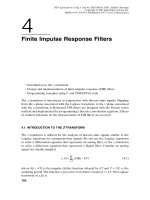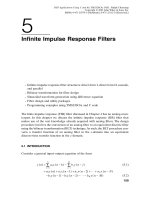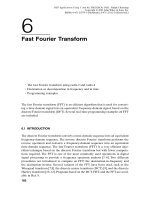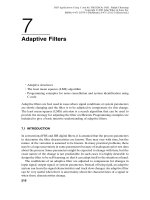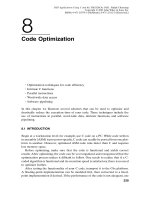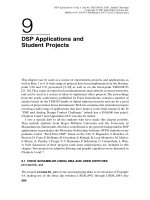Computational finance using c and c derivatives and valuation
Bạn đang xem bản rút gọn của tài liệu. Xem và tải ngay bản đầy đủ của tài liệu tại đây (12.11 MB, 380 trang )
Computational Finance
Using C and C#
Quantitative Finance Series
Aims and Objectives
•
•
•
•
•
•
Books based on the work of financial market practitioners and academics
Presenting cutting-edge research to the professional/practitioner market
Combining intellectual rigour and practical application
Covering the interaction between mathematical theory and financial practice
To improve portfolio performance, risk management and trading book performance
Covering quantitative techniques
Market
Brokers/Traders; Actuaries; Consultants; Asset Managers; Fund Managers; Regulators; Central Bankers; Treasury Officials; Technical Analysis; and Academics for Masters
in Finance and MBA market.
Series Titles
Computational Finance Using C and C#
The Analytics of Risk Model Validation
Forecasting Expected Returns in the Financial Markets
Corporate Governance and Regulatory Impact on Mergers and Acquisitions
International Mergers and Acquisitions Activity Since 1990
Forecasting Volatility in the Financial Markets, Third Edition
Venture Capital in Europe
Funds of Hedge Funds
Initial Public Offerings
Linear Factor Models in Finance
Computational Finance
Advances in Portfolio Construction and Implementation
Advanced Trading Rules, Second Edition
Real R&D Options
Performance Measurement in Finance
Economics for Financial Markets
Managing Downside Risk in Financial Markets
Derivative Instruments: Theory, Valuation, Analysis
Return Distributions in Finance
Series Editor: Dr. Stephen Satchell
Dr. Satchell is Reader in Financial Econometrics at Trinity College, Cambridge;
Visiting Professor at Birkbeck College, City University Business School and University
of Technology, Sydney. He also works in a consultative capacity to many firms, and
edits the journal Derivatives: use, trading and regulations and the Journal of Asset
Management.
Computational Finance
Using C and C#
Derivatives and Valuation
SECOND EDITION
George Levy
AMSTERDAM • BOSTON • HEIDELBERG • LONDON
NEW YORK • OXFORD • PARIS • SAN DIEGO
SAN FRANCISCO • SINGAPORE • SYDNEY • TOKYO
Academic Press is an Imprint of Elsevier
Academic Press is an imprint of Elsevier
125 London Wall, London EC2Y 5AS, UK
525 B Street, Suite 1800, San Diego, CA 92101-4495, USA
50 Hampshire Street, 5th Floor, Cambridge, MA 02139, USA
The Boulevard, Langford Lane, Kidlington, Oxford OX5 1GB, UK
Copyright © 2016, 2008 Elsevier Ltd. All rights reserved.
No part of this publication may be reproduced or transmitted in any form or by any means,
electronic or mechanical, including photocopying, recording, or any information storage and
retrieval system, without permission in writing from the publisher. Details on how to seek
permission, further information about the Publisher’s permissions policies and our arrangements
with organizations such as the Copyright Clearance Center and the Copyright Licensing Agency,
can be found at our website: www.elsevier.com/permissions.
This book and the individual contributions contained in it are protected under copyright by the
Publisher (other than as may be noted herein).
Notices
Knowledge and best practice in this field are constantly changing. As new research and experience
broaden our understanding, changes in research methods, professional practices, or medical
treatment may become necessary.
Practitioners and researchers must always rely on their own experience and knowledge in
evaluating and using any information, methods, compounds, or experiments described herein. In
using such information or methods they should be mindful of their own safety and the safety of
others, including parties for whom they have a professional responsibility.
To the fullest extent of the law, neither the Publisher nor the authors, contributors, or editors,
assume any liability for any injury and/or damage to persons or property as a matter of products
liability, negligence or otherwise, or from any use or operation of any methods, products,
instructions, or ideas contained in the material herein.
Library of Congress Cataloging-in-Publication Data
A catalog record for this book is available from the Library of Congress
British Library Cataloguing-in-Publication Data
A catalogue record for this book is available from the British Library
ISBN: 978-0-12-803579-5
For information on all Academic Press publications
visit our website at />
Publisher: Nikki Levy
Acquisition Editor: J. Scott Bentley
Editorial Project Manager: Susan Ikeda
Production Project Manager: Julie-Ann Stansfield
Designer: Mark Rogers
Typeset by Focal Image (India) Pvt Ltd.
Dedication
To my parents Paul and Paula and also my grandparents Friedrich
and Barbara.
Contents
Preface
1
2
Overview of Financial Derivatives
Introduction to Stochastic Processes
2.1
2.2
2.3
2.4
2.5
2.6
2.7
2.8
2.9
2.10
2.11
2.12
2.13
3
Brownian Motion
A Brownian Model of Asset Price Movements
Ito’s Formula (or Lemma)
Girsanov’s Theorem
Ito’s Lemma for Multi-Asset GBM
Ito Product and Quotient Rules in Two Dimensions
2.6.1 Ito Product Rule
2.6.2 Ito Quotient Rule
Ito Product in n Dimensions
The Brownian Bridge
Time Transformed Brownian Motion
2.9.1 Scaled Brownian Motion
2.9.2 Mean Reverting Process
Ornstein Uhlenbeck Process
The Ornstein Uhlenbeck Bridge
Other Useful Results
2.12.1 Fubini’s Theorem
2.12.2 Ito’s Isometry
2.12.3 Expectation of a Stochastic Integral
Selected Exercises
5
9
10
12
12
14
15
15
17
18
20
21
21
22
25
29
29
29
30
31
Generation of Random Variates
3.1
3.2
3.3
3.4
3.5
4
xvii
Introduction
Pseudo-Random and Quasi-Random Sequences
Generation of Multivariate Distributions: Independent Variates
3.3.1 Normal Distribution
3.3.2 Lognormal Distribution
3.3.3 Student’s t-Distribution
Generation of Multivariate Distributions: Correlated Variates
3.4.1 Estimation of Correlation and Covariance
3.4.2 Repairing Correlation and Covariance Matrices
3.4.3 Normal Distribution
3.4.4 Lognormal Distribution
Selected Exercises
35
36
40
40
43
44
44
44
45
49
53
56
European Options
4.1
4.2
4.3
Introduction
Pricing Derivatives using A Martingale Measure
Put Call Parity
4.3.1 Discrete Dividends
57
57
58
58
vii
viii
Contents
4.4
4.5
4.6
5
59
60
60
63
65
73
78
82
82
82
85
87
90
Single Asset American Options
5.1
5.2
5.3
5.4
5.5
5.6
6
4.3.2 Continuous Dividends
Vanilla Options and the Black–Scholes Model
4.4.1 The Option Pricing Partial Differential Equation
4.4.2 The Multi-asset Option Pricing Partial Differential Equation
4.4.3 The Black–Scholes Formula
4.4.4 Historical and Implied Volatility
4.4.5 Pricing Options with Microsoft Excel
Barrier Options
4.5.1 Introduction
4.5.2 Analytic Pricing of Down and Out Call Options
4.5.3 Analytic Pricing of Up and Out Call Options
4.5.4 Monte Carlo Pricing of Down and Out Options
Selected Exercises
Introduction
Approximations for Vanilla American Options
5.2.1 American Call Options with Cash Dividends
5.2.2 The Macmillan, Barone-Adesi, and Whaley Method
Lattice Methods for Vanilla Options
5.3.1 Binomial Lattice
5.3.2 Constructing and using the Binomial Lattice
5.3.3 Binomial Lattice with a Control Variate
5.3.4 The Binomial Lattice with BBS and BBSR
Grid Methods for Vanilla Options
5.4.1 Introduction
5.4.2 Uniform Grids
5.4.3 Nonuniform Grids
5.4.4 The Log Transformation and Uniform Grids
5.4.5 The Log Transformation and Nonuniform Grids
5.4.6 The Double Knockout Call Option
Pricing American Options using a Stochastic Lattice
Selected Exercises
93
93
93
99
108
108
115
123
125
129
129
131
144
152
156
158
165
173
Multi-asset Options
6.1
6.2
6.3
6.4
6.5
6.6
Introduction
The Multi-asset Black–Scholes Equation
Multidimensional Monte Carlo Methods
Introduction to Multidimensional Lattice Methods
Two-asset Options
6.5.1 European Exchange Options
6.5.2 European Options on the Maximum or Minimum
6.5.3 American Options
Three-asset Options
175
175
176
180
183
183
185
189
193
Contents
6.7
6.8
7
7.3
7.4
7.5
7.6
Introduction
Interest Rate Derivatives
7.2.1 Forward Rate Agreement
7.2.2 Interest Rate Swap
7.2.3 Timing Adjustment
7.2.4 Interest Rate Quantos
Foreign Exchange Derivatives
7.3.1 FX Forward
7.3.2 European FX Option
Credit Derivatives
7.4.1 Defaultable Bond
7.4.2 Credit Default Swap
7.4.3 Total Return Swap
Equity Derivatives
7.5.1 TRS
7.5.2 Equity Quantos
Selected Exercises
203
203
204
205
211
216
221
222
223
225
228
228
229
230
230
233
236
C# Portfolio Pricing Application
8.1
8.2
8.3
8.4
8.5
9
196
198
Other Financial Derivatives
7.1
7.2
8
Four-asset Options
Selected Exercises
ix
Introduction
Storing and Retrieving the Market Data
Equity Deal Classes
8.3.1 Single Equity Option
8.3.2 Option on Two Equities
8.3.3 Generic Equity Basket Option
8.3.4 Equity Barrier Option
FX Deal Classes
8.4.1 FX Forward
8.4.2 Single FX Option
8.4.3 FX Barrier Option
Selected Exercises
239
247
253
254
256
257
262
266
266
267
269
273
A Brief History of Finance
9.1
9.2
9.3
Introduction
Early History
9.2.1 The Sumerians
9.2.2 Biblical Times
9.2.3 The Greeks
9.2.4 Medieval Europe
Early Stock Exchanges
9.3.1 The Anwterp Exchange
275
275
275
277
278
279
280
280
x
Contents
9.4
9.5
9.6
9.7
9.8
A
Introduction
Gamma
Delta
Theta
Rho
Vega
The Normal (Gaussian) Distribution
The Lognormal Distribution
The Student’s t Distribution
The General Error Distribution
D.4.1 Value of λ for Variance hi
D.4.2 The Kurtosis
D.4.3 The Distribution for Shape Parameter, a
325
327
328
330
330
331
332
Mathematical Reference
E.1
E.2
E.3
E.4
F
315
315
317
317
319
321
321
323
Statistical Distribution Functions
D.1
D.2
D.3
D.4
E
307
310
Standard Statistical Results
C.1 The Law of Large Numbers
C.2 The Central Limit Theorem
C.3 The Variance and Covariance of Random Variables
C.3.1 Variance
C.3.2 Covariance
C.3.3 Covariance Matrix
C.4 Conditional Mean and Covariance of Normal Distributions
C.5 Moment Generating Functions
D
301
302
303
303
304
305
Barrier Option Integrals
B.1 The Down and Out Call
B.2 The Up and Out Call
C
281
284
286
289
290
292
296
297
The Greeks for Vanilla European Options
A.1
A.2
A.3
A.4
A.5
A.6
B
9.3.2 Amsterdam Stock Exchange
9.3.3 Other Early Financial Centres
Tulip Mania
Early Use of Derivatives in the USA
Securitisation and Structured Products
Collateralised Debt Obligations
The 2008 Financial Crisis
9.8.1 The Collapse of AIG
Standard Integrals
Gamma Function
The Cumulative Normal Distribution Function
Arithmetic and Geometric Progressions
Black–Scholes Finite-Difference Schemes
333
333
334
335
Contents
F.1
F.2
G
H
337
337
The Brownian Bridge: Alternative Derivation
Brownian Motion: More Results
H.1
H.2
H.3
H.4
H.5
H.6
H.7
H.8
H.9
I
The General Case
The Log Transformation and a Uniform Grid
xi
Some Results Concerning Brownian Motion
Proof of Equation (H.1.2)
Proof of Equation (H.1.4)
Proof of Equation (H.1.5)
Proof of Equation (H.1.6)
Proof of Equation (H.1.7)
Proof of Equation (H.1.8)
Proof of Equation (H.1.9)
Proof of Equation (H.1.10)
345
346
347
347
347
349
349
350
350
Feynman–Kac Formula
I.1
Some Results
Glossary
Bibliography
Further Reading
Index
353
355
357
359
363
List of Figures
Fig. 3.1
Fig. 3.2
Fig. 3.3
Fig. 3.4
Fig. 3.5
Fig. 3.6
Fig. 3.7
Fig. 4.1
Fig. 4.2
Fig. 4.3
Fig. 5.1
Fig. 5.2
Fig. 5.3
Fig. 5.4
Fig. 5.5
Fig. 5.6
Fig. 5.7
Fig. 5.8
Fig. 5.9
Fig. 5.10
Fig. 9.1
Fig. 9.2
Fig. 9.3
Fig. 9.4
Fig. 9.5
The scatter diagram formed by 1000 points from a 16-dimensional U (0, 1)
pseudo-random sequence.
The scatter diagram formed by 1000 points from a 16-dimensional U (0, 1)
Sobol sequence.
The scatter diagram formed by 1000 points from a 16-dimensional U (0, 1)
Niederreiter sequence.
Monte Carlo integration using random numbers.
Scatter diagram for a sample of 3000 observations (Z i , i = 1, . . . , 3000)
generated from a multivariate normal distribution consisting of three variates
with covariance matrix C 1 and mean µ.
Scatter diagram for a sample of 3000 observations (Z i , i = 1, . . . , 3000)
generated from a multivariate normal distribution consisting of three variates
with covariance matrix C 2 and mean µ.
Scatter diagram for a sample of 3000 observations (Z i , i = 1, . . . , 3000)
generated from a multivariate normal distribution consisting of three variates
with covariance matrix C 3 and mean µ.
Using the function bs_opt interactively within Excel. Here, a call option is
proceed with the following parameters: S = 10.0, X = 9.0, q = 0.0, T =
1.5, r = 0.1, and σ = 0.2.
Excel worksheet before calculation of the European option values.
Excel worksheet after calculation of the European option values.
A standard binomial lattice consisting of six time steps.
The error in the estimated value, est_val, of an American put using a standard
binomial lattice.
The error in the estimated value, est_val, of an American call using both a
standard binomial lattice and a BBS binomial lattice.
The error in the estimated value, est_val, of an American call, using a BBSR
binomial lattice.
An example uniform grid, which could be used to estimate the value of a vanilla
option which matures in two-year time.
A nonuniform grid in which the grid spacing is reduced near current time t and
also in the neighbourhood of the asset price 25; this can lead to greater accuracy
in the computed option values and the associated Greeks.
The absolute error in the estimated values for a European down and out call
barrier option (B < E) as the number of asset grid points, n s , is varied.
The absolute error in the estimated values for a European down and out call
barrier option (E < B) as the number of asset grid points, n s , is varied.
An example showing the asset prices generated for a stochastic lattice with three
branches per node and two time steps, that is, b = 3 and d = 3.
The option prices for the b = 3 and d = 3 lattice in Fig. 5.9 corresponding to an
American put with strike E = 100 and interest rate r = 0.
Interest-free loan (inner tablet), from Sippar, reign of Sabium (Old Babylonian
period, c.1780 BC); BM 082512.
The outer clay envelope of BM 082512. (Old Babylonian period, c.1780 BC);
BM 082513.
Eliezer and Rebecca at the Well, Nicolas Poussin, 1648.
Padagger tower Antwerpen Old Exchange building at Hofstraat 15 Antwerpen
(Mark Ahsmann).
The New Exchange, Antwerp, first built in 1531. It burnt down in 1858 and was
rebuilt in the gothic style.
37
38
38
39
53
54
54
80
81
81
114
123
128
129
141
146
149
150
167
169
276
276
278
280
281
xiii
xiv
Fig. 9.6
Fig. 9.7
Fig. 9.8
Fig. 9.9
Fig. 9.10
Fig. 9.11
Fig. 9.12
Fig. 9.13
Fig. 9.14
Fig. 9.15
List of Figures
The Courtyard of the Old Exchange in Amsterdam, Emanuel de Witte (1617–
1692).
Map of the Cape of Good Hope up to and including Japan (Isaac de Graaff),
between 1690 and 1743.
A share certificate issued by the Dutch East India Company.
The Royal Exchange, London.
Map of New Amsterdam in 1600 showing the wall from which Wall Street is
named.
Pamphlet from the Dutch tulipomania, printed in 1637.
Semper Augustus tulip, 17th century.
Typical mortgage-backed security flow chart.
Typical collateralised debt obligation flow chart.
Typical synthetic collateralised debt obligation flow chart.
282
283
283
285
285
287
288
293
294
295
List of Tables
Table 4.1
Table 4.2
Table 4.3
Table 5.1
Table 5.2
Table 5.3
Table 5.4
Table 5.5
Table 5.6
Table 5.7
Table 5.8
Table 5.9
Table 5.10
Table 5.11
Table 5.12
Table 5.13
Table 6.1
Table 6.2
Table 6.3
Table 6.4
Table 6.5
Table 6.6
Table 6.7
Table 6.8
Table 6.9
Table 6.10
European Put: Option Values and Greeks. The Parameters are S = 100.0, E =
100.0, r = 0.10, σ = 0.30, and q = 0.06
European Call: Option Values and Greeks. The Parameters are S = 100.0, E =
100.0, r = 0.10, σ = 0.30, and q = 0.06
Calculated Option Values and Implied Volatilities from Code excerpt 4.4
A Comparison of the Computed Values for American Call Options with
Dividends, using the Roll, Geske, and Whaley Approximation, and the Black
Approximation
The Macmillan, Barone-Adesi, and Whaley Method for American Option
Values Computed by the Routine MBW_approx
The Macmillan, Barone-Adesi, and Whaley Critical Asset Values for the Early
Exercise Boundary of an American Put Computed by the Routine MBW_approx
Lattice Node Values in the Vicinity of the Root Node R
The Pricing Errors for an American Call Option Computed by a Standard
Binomial Lattice, a BBS Lattice, and also a BBSR Lattice
The Pricing Errors for an American Put Option Computed by a Standard
Binomial Lattice, a BBS Lattice, and also a BBSR Lattice
Valuation Results and Pricing Errors for a Vanilla American Put Option using
a Uniform Grid with and without a Logarithmic Transformation; the Implicit
Method and Crank–Nicolson Method are used
Estimated Value of a European Double Knock Out Call Option
The Estimated Values of European Down and Out Call Options Calculated by
the Function dko_call
The Estimated Values of European Down and Out Call Options as Calculated
by the Function dko_call
The Estimated Values of European Double Knock Out Call Options Computed
by the Function dko_call
The Estimated Greeks for European Double Knock Out Call Options Computed
by the Function dko_call
American Put Option Values Computed using a Stochastic Lattice
The Computed Values and Absolute Errors, in Brackets, for European Options
on the Maximum of Three Assets
The Computed Values and Absolute Errors, in Brackets, for European Options
on the Minimum of Three Assets
The Computed Values and Absolute Errors for European Put and Call Options
on the Maximum of Two Assets
The Computed Values and Absolute Errors for European Put and Call Options
on the Minimum of Two Assets
The Computed Values and Absolute Errors for European Options on the
Maximum of Three Assets
The Computed Values and Absolute Errors for European Options on the
Minimum of Three Assets
The Computed Values and Absolute Errors for European Options on the
Maximum of Three Assets
The Computed Values and Absolute Errors for European Options on the
Minimum of Three Assets
The Computed Values and Absolute Errors for European Options on the
Maximum of Four Assets
The Computed Values and Absolute Errors for European Options on the
Minimum of Four Assets
74
74
78
97
108
109
119
130
131
155
159
162
163
164
165
172
177
178
190
191
196
197
199
199
200
201
xv
Preface
It has been seven years since the initial publication of Computational Finance
Using C and C#, and in that time the Global Credit Crisis has come and gone.
The author therefore thought that it would be opportune to both correct various
errors and update the contents of the first edition. Numerous problems/exercises
and C# software have been included, and both the solutions to these exercises
and the software can be downloaded from the book’s companion website.
/>There is also now a short chapter on the History of Finance, from the
Babylonians to the 2008 Credit Crisis. It was inspired by my friend Ian Brown
who wanted me to write something on the Credit Crisis that he could understand
- I hope this helps.
As always I would like to take this opportunity of thanking my wife Kathy
for putting up with the amount of time I spend on my computer.
Thanks are also due to my friend Vince Fernando, who many years ago now,
suggested that I should write a book - until then the thought hadn’t occurred to
me.
I am grateful to Dr. J. Scott Bentley, Susan Ikeda and Julie-Ann Stansfield
of Elsevier for all their hard work and patience, and also the series editor Dr.
Steven Satchell for allowing me to create this second edition.
George Levy
Benson
November 2015
xvii
Chapter 1
Overview of Financial
Derivatives
A financial derivative is a contract between two counterparties (here referred
to as A and B), which derives its value from the state of underlying financial
quantities. We can further divide derivatives into those which carry a future
obligation and those which do not. In the financial world, a derivative which
gives the owner the right but not the obligation to participate in a given financial
contract is called an option. We will now illustrate this using both a Foreign
Exchange Forward contract and a Foreign Exchange option.
Foreign Exchange Forward – A Contract with an Obligation
In a Foreign Exchange Forward contract, a certain amount of foreign currency
will be bought (or sold) at a future date using a prearranged foreign exchange
rate.
For instance, counterparty A may own a Foreign Exchange forward which,
in 1-year time, contractually obliges A to purchase from B, the sum of $200 for
£100. At the end of one year, several things may have happened.
(i) The value of the pound may have decreased with respect to the dollar.
(ii) The value of the pound may have increased with respect to the dollar.
(iii) Counterparty B may refuse to honour the contract – B may have gone bust,
etc.
(iv) Counterparty A may refuse to honour the contract – A may have gone bust,
etc.
We will now consider events (i)–(iv) from A’s perspective.
First, if (i) occurs then A will be able to obtain $200 for less than the current
market rate, say £120. In this case, the $200 can be bought for £100 and then
immediately sold for £120, giving a profit of £20. However, this profit can only
be realised if B honours the contract, that is, event (iii) does not happen.
Second, when (ii) occurs then A is obliged to purchase $200 for more than
the current market rate, say £90. In this case, the $200 are be bought for £100
but could have been bought for only £90, giving a loss of £10.
The probability of events (iii) and (iv) occurring are related to the Credit Risk
associated with counterparty B. The value of the contract to A is not affected by
(iv), although A may be sued if both (ii) and (iv) occur. Counterparty A should
only be concerned with the possibility of events (i) and (iii) occurring, that is
Computational Finance Using C and C#: Derivatives and Valuation. DOI: 10.1016/B978-0-12803579-5.00008-5
Copyright © 2016 Elsevier Ltd. All rights reserved.
1
2
CHAPTER| 1
Overview of Financial Derivatives
the probability that the contract is worth a positive amount in one year and
probability that B will honour the contract (which is one minus the probability
that event (iii) will happen).
From B’s point of view, the important Credit Risk is when both (ii) and
(iv) occur, that is, when the contract has positive value but counterparty A
defaults.
Foreign Exchange Option – A Contract without an Obligation
A Foreign Exchange option is similar to the Foreign Exchange Forward, the
difference is that if event (ii) occurs then A is not obliged to buy dollars at an
unfavourable exchange rate. To have this flexibility, A needs to buy a Foreign
Exchange option from B, which here we can be regarded as insurance against
unexpected exchange rate fluctuations.
For instance, counterparty A may own a Foreign Exchange option which, in
one year, contractually allows A to purchase from B, the sum of $200 for £100.
As before, at the end of one year the following may have happened.
(i) The value of the pound may have decreased with respect to the dollar.
(ii) The value of the pound may have increased with respect to the dollar.
(iii) Counterparty B may refuse to honour the contract – B may have gone bust,
etc.
(iv) Counterparty A may have gone bust, etc.
We will now consider events (i)–(iv) from A’s perspective.
First, if (i) occurs then A will be able to obtain $200 for less than the current
market rate, say £120. In this case, the $200 can be bought for £100 and then
immediately sold for £120, giving a profit of £20. However, this profit can only
be realised if B honours the contract, that is, event (iii) does not happen.
Second, when (ii) occurs then A will decide not to purchase $200 for more
than the current market rate – in this case, the option is worthless.
We can thus see that A is still concerned with the Credit Risk when events
(i) and (iii) occur simultaneously.
The Credit Risk from counterparty B’s point of view is different. B has sold
to A a Foreign Exchange option, which matures in one year and has already
received the money – the current fair price for the option. Counterparty B has
no Credit Risk associated with A. This is because if event (iv) occurs, and A
goes bust, it does not matter to B since the money for the option has already
been received. On the other hand, if event (iii) occurs B may be sued by A but
B still has no Credit Risk associated with A.
This book considers the valuation of financial derivatives which carry
obligations and also financial options.
Chapters 1–7 deal with both the theory of stochastic processes and the
pricing of financial instruments. In Chapter 8, this information is then applied to
a C# portfolio valuer. The application is easy to use (the portfolios and current
Foreign Exchange Option – A Contract without an Obligation Section|
3
market rates are defined in text files) and can also be extended to include new
trade types.
The book has been written so that (as far possible) financial mathematics
results are derived from first principles.
Finally, the appendices contain various information which it is hoped the
reader will find useful.
Chapter 2
Introduction to Stochastic
Processes
2.1 BROWNIAN MOTION
Brownian motion is named after the botanist Robert Brown who used a
microscope to study the fertilization mechanism of flowering plants. He first
observed the random motion of pollen particles (obtained from the American
species Clarkia pulchella) suspended in water and wrote the following:
The fovilla or granules fill the whole orbicular disk but do not
extend to the projecting angles. They are not spherical but oblong
or nearly cylindrical, and the particles have manifest motion. This
motion is only visible to my lens which magnifies 370 times. The
motion is obscure yet certain ..
Robert Brown, 12th June 1827; see Ramsbottom (1932)
It appears that Brown considered this motion no more than a curiosity
(he believed that the particles were alive) and continued undistracted with
his botanical research. The full significance of his observations only became
apparent about eighty years later when it was shown (Einstein, 1905) that
the motion is caused by the collisions that occur between the pollen grains
and the water molecules. In 1908 Perrin, see Perrin (1910), was finally able
to confirm Einstein’s predictions experimentally. His work was made possible
by the development of the ultramicroscope by Richard Zsigmondy and Henry
Siedentopf in 1903. He was able to work out from his experimental results
and Einstein’s formula the size of the water molecule and a precise value for
Avogadro’s number. His work established the physical theory of Brownian
motion and ended the skepticism about the existence of atoms and molecules
as actual physical entities. Many of the fundamental properties of Brownian
motion were discovered by Paul Levy, see Levy (1939), and Levy (1948), and
the first mathematically rigorous treatment was provided by Norbert Wiener, see
Wiener (1923) and Wiener (1924). In addition, see Karatzas and Shreve (2000),
is an excellent text book on the theoretical properties of Brownian motion,
while Shreve et. al., see Shreve et al. (1997), provides much useful information
concerning the use of Brownian processes within finance.
Computational Finance Using C and C#: Derivatives and Valuation. DOI: 10.1016/B978-0-12803579-5.00009-7
Copyright © 2016 Elsevier Ltd. All rights reserved.
5
6
CHAPTER| 2
Introduction to Stochastic Processes
Brownian motion is also called a random walk, a Wiener process, or
sometimes (more poetically) the drunkards walk. We will now present the three
fundamental properties of Brownian motion.
The Properties of Brownian Motion
In formal terms, a process is W = (Wt : t ≥ 0) is (one-dimensional) Brownian
motion if
(i) Wt is continuous, and W0 = 0,
(ii) Wt ∼ N(0,t),
(iii) the increment dWt = Wt+dt −Wt is normally distributed as dWt ∼ N(0, dt),
so E[dWt ] = 0 and V ar[dWt ] = dt. The increment dWdt is also independent of the history of the process up to time t.
From (iii), we can further state that, since the increments dWt are independent of past values Wt , a Brownian process is also a Markov process. In addition,
we shall now show that Brownian process is also a martingale process.
In a martingale process Pt , t ≥ 0, the conditional expectation E[Pt+dt |Ft ] =
Pt , where Ft is called the filtration generated by the process and contains the
information learned by observing the process up to time t. Since for Brownian
motion, we have
E[Wt+dt |Ft ] = E[(Wt+dt − Wt ) + Wt |Ft ] = E[Wt+dt − Wt ] + Wt
= E[dWt ] + Wt = Wt ,
where we have used the fact that E[dWt ] = 0. Since E[Wt+dt |Ft ] = Wt , the
Brownian motion Z is a martingale process.
Using property (iii) we can also derive an expression for the covariance of
Brownian motion. The independent increment requirement means that for the
n times 0 ≤ t 0 < t 1 < t 2 . . . ,t n < ∞ the random variables Wt1 − Wt0 ,Wt2 −
Wt1 , . . . ,Wt n − Wt n−1 are independent. So
Cov Wt i − Wt i−1 ,Wt j − Wt j−1 = 0,
i
j.
(2.1.1)
We will show that Cov [Ws ,Wt ] = s ∧ t.
Proof. Using Wt0 = 0 and assuming t ≥ t, we have
Cov Ws − Wt0 ,Wt − Wt0 = Cov [Ws ,Wt ] = Cov [Ws ,Ws + (Wt − Ws )] .
From Appendix C.3.2, we have
Cov [Ws ,Ws + (Wt − Ws )] = Cov [Ws ,Ws ] + Cov [Ws ,Wt − Ws ]
= V ar [Ws ] + Cov [Ws ,Wt ]
= s + Cov [Ws ,Wt − Ws ] .
Brownian Motion Section| 2.1
7
Now since
Cov [Ws ,Wt ] = Cov Ws − Wt0 ,Wt − Ws = 0,
where we have used equation (2.1.1) with n = 2, t 1 = t s , and t 2 = t.
We thus obtain
Cov [Ws ,Wt ] = s.
So
Cov [Ws ,Wt ] = s ∧ t.
(2.1.2)
We will now consider the Brownian increments over the time interval dt in
more detail. Let us first define the process X such that
dX t = dWt ,
(2.1.3)
where dWt is a random variable drawn from a normal distribution with mean
zero and variance dt, which we denote as dWt ∼ N(0, dt). Equation (2.1.3) can
also be written in the equivalent form
√
(2.1.4)
dX t = dt dZ,
where dZ is a random variable drawn from a standard normal distribution (that
is a normal distribution with zero mean and unit variance).
Equations (2.1.3) and (2.1.4) give the incremental change in the value of X
over the time interval dt for standard Brownian motion.
We shall now generalize these equations slightly by introducing the extra
(volatility) parameter σ which controls the variance of the process. We now
have
dX t = σdWt ,
(2.1.5)
2
where dWt ∼ N(0, dt) and dX t ∼ N(0, σ dt). Equation (2.1.5) can also be
written in the equivalent form as
dX t = σ
or equivalently
dX t =
√
√
dt dZ,
ˆ
dt d Z,
dZ ∼ N(0, 1),
d Zˆ ∼ N(0, σ 2 ).
(2.1.6)
(2.1.7)
We are now in a position to provide a mathematical description of the movement
of the pollen grains observed by Robert Brown in 1827. We will start by
assuming that the container of water is perfectly level. This will ensure that
there is no drift of the pollen grains in any particular direction. Let us denote the
position of a particular pollen grain at time t by X t , and set the position at t = 0,
X t0 , to zero. The statistical distribution of the grain’s position, XT , at some later
time t = T, can be found as follows.
Let us divide the time T into n equal intervals
√ dt = T/n. Since the position of
the particle changes by the amount dX i = σ dt dZi over the ith time interval
dt, the final position XT is given by
XT =
n √
n
√
σ dt dZi = σ dt
dZi .
i=1
i=1


